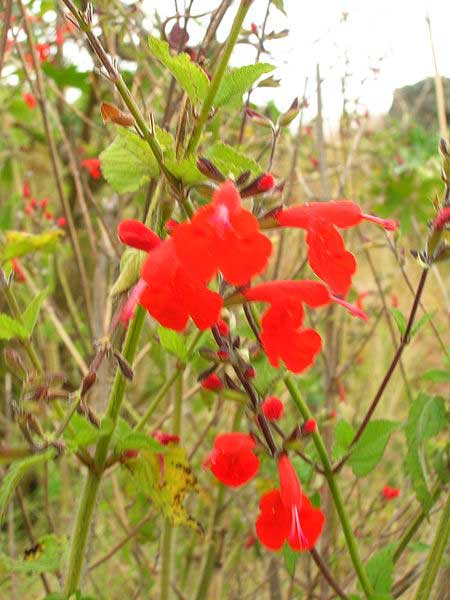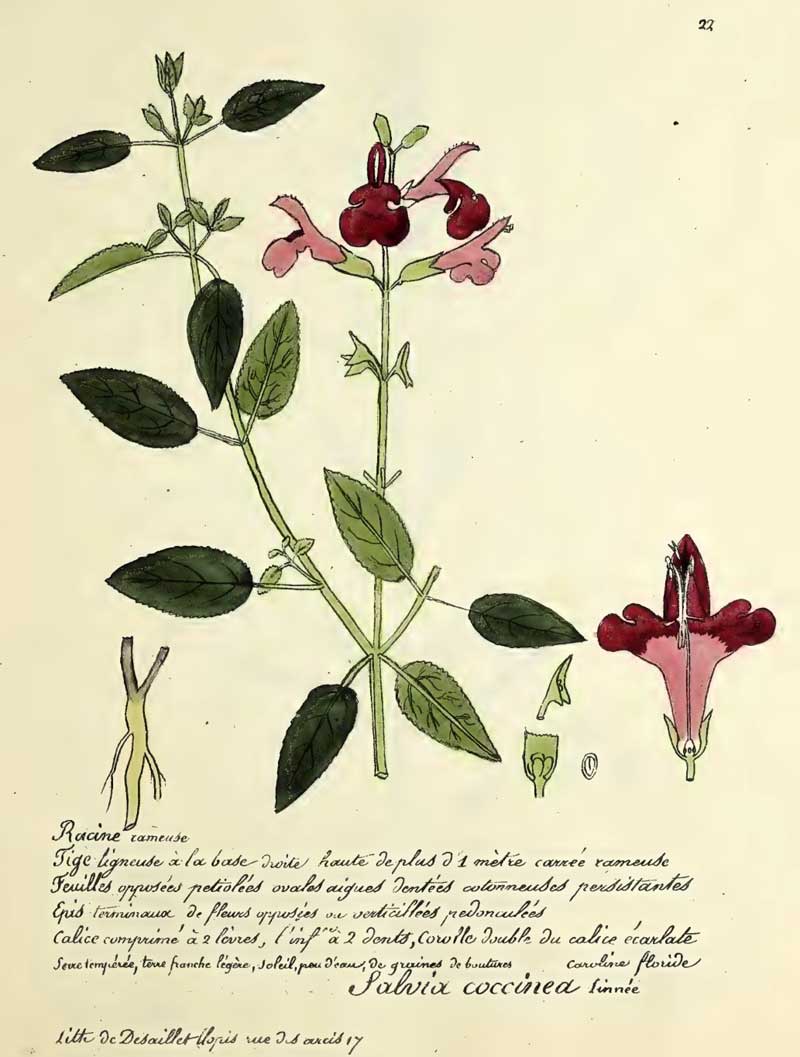
Salvia coccinea (Photo: Forest & Kim Starr)
Classification System: APG IV
Superregnum: Eukaryota
Regnum: Plantae
Cladus: Angiosperms
Cladus: Eudicots
Cladus: Core eudicots
Cladus: Asterids
Cladus: Lamiids
Ordo: Lamiales
Familia: Lamiaceae
Subfamilia: Nepetoideae
Tribus: Mentheae
Subtribus: Salviinae
Genus: Salvia
Subgenus: S. subg. Calosphace
Sectio: S. sect. Calosphace
Species: Salvia coccinea
Name
Salvia coccinea Buc'hoz ex Etl., Salv. 23. 1777.
Synonyms
Homotypic
Horminum coccineum (Buc'hoz ex Etl.) Moench, Methodus: 377. 1794.
Heterotypic
Salvia ciliata Benth., Labiat. Gen. Spec.: 286. 1833, nom. illeg.
Salvia coccinea L.f., Suppl. Pl.: 88. 1782, nom. illeg.
Salvia coccinea f. pseudococcinea (Jacq.) Voss, Vilm. Blumengärtn. ed. 3, 1: 839. 1895.
Salvia coccinea var. minima Fernald, Proc. Amer. Acad. Arts 35: 551. 1900.
Salvia coccinea var. pseudococcinea (Jacq.) A.Gray, Syn. Fl. N. Amer. 2(1): 368. 1886.
Salvia filamentosa Tausch, Flora 25: 282. 1842.
Salvia galeottii M.Martens, Bull. Acad. Roy. Sci. Bruxelles 11(2): 75. 1844.
Salvia glaucescens Pohl, Pl. Bras. Icon. Descr. 2: t. 192. 1833.
Salvia mollissima M.Martens & Galeotti, Bull. Acad. Roy. Sci. Bruxelles 11(2): 71. 1844.
Salvia pseudococcinea Jacq., Collectanea 2: 302. 1789.
Salvia rosea Vahl, Enum. Pl. Obs. 1: 244. 1804.
Salvia superba Vilm., Fl. Pleine Terre: 769. 1863.

References
Etlinger, A.E. (1777) Salv. 23.
Govaerts, R. et al. 2015. Salvia coccinea in World Checklist of Selected Plant Families. The Board of Trustees of the Royal Botanic Gardens, Kew. Published on the internet. Accessed: 2015 Sep 14. Reference page.
USDA, ARS, Germplasm Resources Information Network. Salvia coccinea in the Germplasm Resources Information Network (GRIN), U.S. Department of Agriculture Agricultural Research Service. Accessed: 09-Oct-10.
Vernacular names
Deutsch: Blut-Salbei
English: Red sage
Kūki'Āirani: tītānia
lea faka-Tonga: teʻekosi
Salvia coccinea, the blood sage,[1] scarlet sage, Texas sage, or tropical sage,[2] is a herbaceous perennial in the family Lamiaceae that is widespread throughout the Southeastern United States, Mexico, Central America, the Caribbean, and northern South America (Colombia, Peru, and Brazil).[2] At one time Brazil was considered to be where it originated, but its diploid chromosome count now points to Mexico as its place of origin.[3]
Taxonomy
Its specific epithet, coccinea, means "scarlet-dyed" (Latin), referring to the color of its flowers.[4]
Description
The plant reaches 2 to 4 ft (0.61 to 1.22 m) in height, with many branches, and a spread of about 2.5 ft (0.76 m). The hairy leaves, scalloped on the edges, are pea green, varying in size, all the way up to 3 in (7.6 cm) long and 2 in (5.1 cm) wide. Flower color and size is quite variable.[3] The naturalized variety is typically tubular, bright red, about 1.25 in (3.2 cm) long.[5] Flowers are pollinated by hummingbirds and butterflies.[6]
Cultivation
Salvia coccinea is an annual species. It is cultivated in urban green areas as well as in private gardens around the world. It has a long flowering period, from the start of summer to the end of autumn.[7][failed verification] Cultivated varieties include orange-red, pink, salmon, red, white, and scarlet, as well as bi-colored varieties.[3] The plant is hardy to USDA Hardiness Zones Zones 8–10.[8]
References
USDA, NRCS (n.d.). "Salvia coccinea". The PLANTS Database (plants.usda.gov). Greensboro, North Carolina: National Plant Data Team. Retrieved 28 October 2015.
"Salvia coccinea". Germplasm Resources Information Network (GRIN). Agricultural Research Service (ARS), United States Department of Agriculture (USDA). Retrieved 2009-12-15.
Clebsch, Betsy; Barner, Carol D. (2003). The New Book of Salvias. Timber Press. pp. 82–84. ISBN 978-0-88192-560-9.
Holloway, Joel Ellis; Neill, Amanda (2005). A Dictionary of Common Wildflowers of Texas & the Southern Great Plains. TCU Press. p. 135. ISBN 978-0-87565-309-9.
Nelson, Gil (2005). East Gulf Coastal Plain Wildflowers. Globe Pequot. p. 212. ISBN 978-0-7627-2718-6.
"#507 Salvia coccinea". Floridata. Retrieved 2010-01-29.
Stratu, Anişoara; Costică, Naela (2015-10-01). "The Influence Of Zinc On Seed Germination And Growth In The First Ontogenetic Stages In The Species Cucumis Melo L." Present Environment and Sustainable Development. 9 (2): 215–228. doi:10.1515/pesd-2015-0038. ISSN 2284-7820.
Fine Gardening: Salvia coccinea (Texas sage, Hummingbird sage)
Retrieved from "http://en.wikipedia.org/"
All text is available under the terms of the GNU Free Documentation License

